One way you could save the data would be to write it to the registry, under the HKCU node. This way different users of your application will have their own settings even if the app is on the same machine. It also keeps the file system a little cleaner and doesn't require a database. But the downside is that the favorites only live on the machine, and don't roam with the user across devices.
A way to implement this would be to wrap your form settings in a class that knows how to save and load values from the registry. This, along with a registry helper class, could make it pretty easy to add "Favorites" functionality to your form.
For example, you could first create a Registry helper class that will read and write settings to the HKCU node (so the settings are specific to the logged in user):
public class RegHelper
{
private static readonly RegistryKey Root = Registry.CurrentUser
.CreateSubKey(@"Software\CompanyName\ApplicationName");
private readonly RegistryKey _thisKey = Root;
public RegHelper() { }
public RegHelper(string favoriteKey)
{
_thisKey = Root.CreateSubKey(favoriteKey);
}
public List<string> GetSubKeys()
{
return _thisKey.GetSubKeyNames().ToList();
}
public void SetProperty(string propertyName, string value)
{
_thisKey.SetValue(propertyName, value, RegistryValueKind.String);
}
public void SetProperty(string propertyName, bool value)
{
SetProperty(propertyName, value.ToString());
}
public string GetProperty(string propertyName)
{
return GetProperty(propertyName, string.Empty);
}
public string GetProperty(string propertyName, string defaultValue)
{
return _thisKey.GetValue(propertyName, defaultValue).ToString();
}
public bool GetPropertyAsBool(string propertyName)
{
return bool.Parse(GetProperty(propertyName, default(bool).ToString()));
}
}
Then, you could wrap the fields of your form into a class that not only has properties that match your form fields, but also has methods to save the values to the registry and some static methods to load all Favorites or a specific named Favorite. For example:
public class Favorite
{
public string Name { get; private set; }
public string Notes { get; set; }
public bool NotesFromPlanner { get; set; }
public string Project { get; set; }
public string DbLocation { get; set; }
public string AssesmentToolVersion { get; set; }
public string ProjectCodes { get; set; }
public bool StraightToNew { get; set; }
public Favorite(string name)
{
this.Name = name;
}
public void Save()
{
var reg = new RegHelper(this.Name);
reg.SetProperty("Name", Name);
reg.SetProperty("Notes", Notes);
reg.SetProperty("NotesFromPlanner", NotesFromPlanner);
reg.SetProperty("Project", Project);
reg.SetProperty("DbLocation", DbLocation);
reg.SetProperty("AssesmentToolVersion", AssesmentToolVersion);
reg.SetProperty("ProjectCodes", ProjectCodes);
reg.SetProperty("StraightToNew", StraightToNew);
}
public static Favorite GetFavorite(string favoriteName)
{
var reg = new RegHelper(favoriteName);
return new Favorite(favoriteName)
{
Notes = reg.GetProperty("Notes"),
NotesFromPlanner = reg.GetPropertyAsBool("NotesFromPlanner"),
Project = reg.GetProperty("Project"),
DbLocation = reg.GetProperty("DbLocation"),
AssesmentToolVersion = reg.GetProperty("AssesmentToolVersion"),
ProjectCodes = reg.GetProperty("ProjectCodes"),
StraightToNew = reg.GetPropertyAsBool("StraightToNew"),
};
}
public static List<Favorite> GetFavorites()
{
return new RegHelper().GetSubKeys().Select(GetFavorite).ToList();
}
public override string ToString()
{
return this.Name;
}
}
Then, you could use the Favorite class to populate your Favorites drop down:
private void Form1_Load(object sender, EventArgs e)
{
// Get all saved favorites and load them up in the combo box
foreach (var favorite in Favorite.GetFavorites())
{
cboFavorites.Items.Add(favorite);
}
}
Now, when a favorite is picked from the combo box, we want to populate our form with the details:
private void cboFavorites_SelectedIndexChanged(object sender, EventArgs e)
{
var favorite = (Favorite) cboFavorites.SelectedItem;
txtNotes.Text = favorite.Notes;
txtAssetToolVersion.Text = favorite.AssesmentToolVersion;
txtDbLocation.Text = favorite.DbLocation;
chkNotesFromPlanner.Checked = favorite.NotesFromPlanner;
txtProjectCodes.Text = favorite.ProjectCodes;
cboProjects.Text = favorite.Project;
chkStraightToNew.Checked = favorite.StraightToNew;
}
And when someone clicks "Save Favorite", we want to add (or update) the favorite details to the registry:
private void btnAddFavorite_Click(object sender, EventArgs e)
{
string favoriteName = cboFavorites.Text;
if (string.IsNullOrEmpty(favoriteName))
{
MessageBox.Show("Please type a name for the favorite in the Favorites box.");
return;
}
var favorite = new Favorite(favoriteName)
{
Notes = txtNotes.Text,
AssesmentToolVersion = txtAssetToolVersion.Text,
DbLocation = txtDbLocation.Text,
NotesFromPlanner = chkNotesFromPlanner.Checked,
ProjectCodes = txtProjectCodes.Text,
Project = cboProjects.Text,
StraightToNew = chkStraightToNew.Checked
};
favorite.Save();
// When saving a favorite, add it to the combo box
// (remove the old one first if it already existed)
var existingFav = cboFavorites.Items.Cast<Favorite>()
.FirstOrDefault(fav => fav.Name == favoriteName);
if (existingFav != null)
{
cboFavorites.Items.Remove(existingFav);
}
cboFavorites.Items.Add(favorite);
cboFavorites.Text = favoriteName;
}
This should be enough to get you started, if you want to go the registry route.
